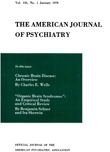ICTAL DEPRESSION AND ANXIETY IN TEMPORAL LOBE DISORDERS
Abstract
Whereas affective disturbances may accompany almost any organic cerebral disorder, the occurrence of "ictal emotions" (suddenly occurring and again disappearing emotional reactions) are frequently associated with disorders of the temporal lobe.
We noted a distinct relationship between paroxysmal, depressive reactions and uncinate attacks. Ictal depressions lasting from hours to weeks occurred in 7 subjects whose principal seizure manifestations consisted of uncinate attacks and temporal lobe automatisms. Depressive episodes preceded or followed temporal lobe seizures or occurred paroxysmally in the "free interval" between seizures. Serial EEG's demonstrate that this particular type of depressive reaction may be due to subclinica 'hippocampal-amygdaloid-temporal lobe epilepsy" and/or due to afterdischarges from the same structures following manifest seizure activation.
The occurrence of paroxysmal fear, or "isolated anxiety" has been sporadically mentioned in the literature as a correlate of temporal lobe seizures, particularly as expression of a temporal lobe aura. We noted "paroxysmal anxiety" in 4 subjects, not only immediately preceding temporal lobe seizures, but also as an "isolated," affective phenomenon in the so-called "free interval." These anxiety attacks seem to bear a relationship to "firing" of the temporal lobe cortex, as demonstrated by our serial EEG observations and as evidenced by Penfield and co-workers during electrical stimulation. [SEE FIG. 7. IN SOURCE PDF.]
Access content
To read the fulltext, please use one of the options below to sign in or purchase access.- Personal login
- Institutional Login
- Sign in via OpenAthens
- Register for access
-
Please login/register if you wish to pair your device and check access availability.
Not a subscriber?
PsychiatryOnline subscription options offer access to the DSM-5 library, books, journals, CME, and patient resources. This all-in-one virtual library provides psychiatrists and mental health professionals with key resources for diagnosis, treatment, research, and professional development.
Need more help? PsychiatryOnline Customer Service may be reached by emailing [email protected] or by calling 800-368-5777 (in the U.S.) or 703-907-7322 (outside the U.S.).



